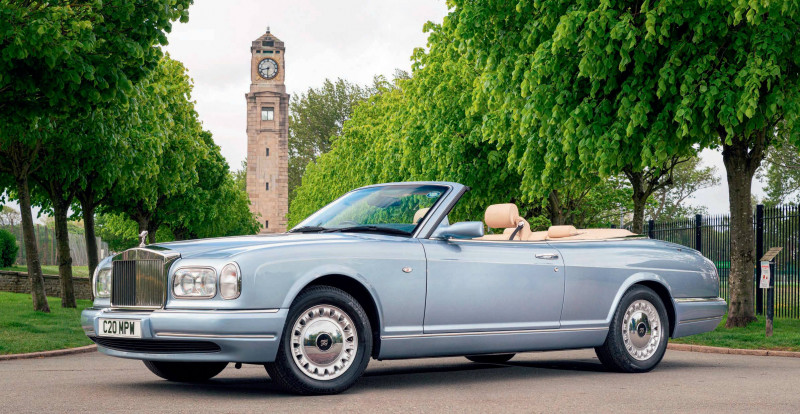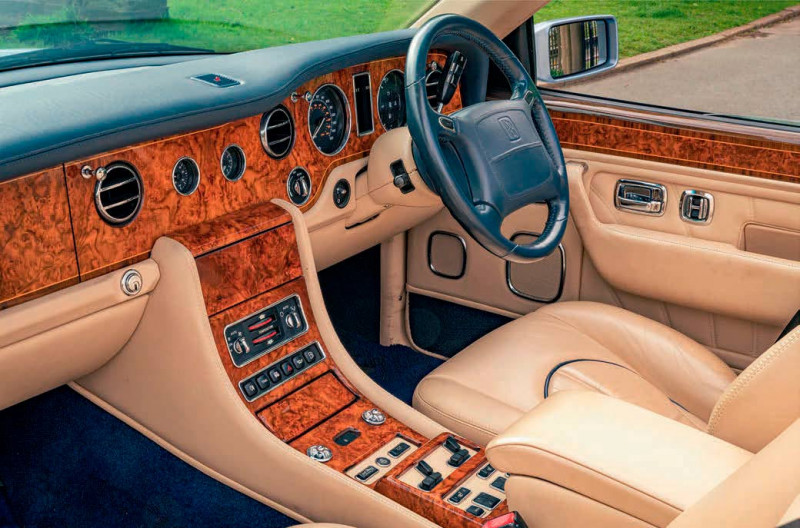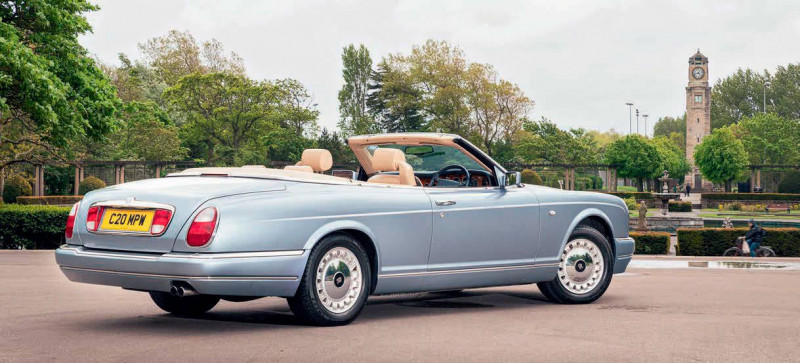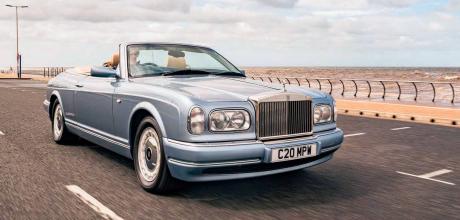2000 Rolls-Royce Corniche V
As a former official dealer who’s had countless Rolls-Royces pass through his hands, John McGlynn is particularly fond of this Corniche V, a car that represents a special kind of finality.
A FITTING FINALE CORNICHE V
One of today’s rarest modern classics is a UK-spec 2000 Rolls-Royce Corniche V – and we’ve managed to track down a superb, low-mileage survivor
As with the finest penthouse or multi-million-dollar yacht, the ultimate luxury of a convertible isn’t in the practical but something rather less tangible. That the Silver Shadow-based drophead-coupé – later relaunched as the Corniche – ran from 1967 to 1995 with remarkably few major updates shows how impervious to material change it could be. Its appeal lay far deeper than any need to remain on trend or to bring aesthetic updates purely for the sake of them.

The eventual loss of the Corniche IV in 1995, however, meant the only soft-top emanating from Crewe in the second half of the decade was the Bentley Azure, a model developed from the Continental R coupé. And this left the Rolls-Royce marque without a convertible for the first time in several decades, the company’s focus at the time being on the forthcoming Silver Seraph saloon and its Bentley Arnage sibling. The launch of that duo 1998, however, would be followed by a change of ownership for both Rolls-Royce and Bentley, with German rivals BMW and Volkswagen entering into a well-publicised spat over which company had acquired what assets from previous owner Vickers.
“The loss of the Corniche IV in 1995 meant the only soft-top emanating from Crewe in the second half of the decade was the Bentley Azure”

The end result was that Volkswagen would continue to run (and own) the two famous British marques for the next four years or so, with BMW taking over the rights to Rolls-Royce (leading to the creation of Rolls-Royce Motor Cars) at the start of 2003. Volkswagen was effectively acting as caretaker of Rolls-Royce, keeping the marque alive and the Silver Seraph in production while inevitably focusing on Bentley in terms of new-model development. Intriguingly, however, there was a new Rolls-Royce launched during that brief period of VW ownership. Unveiled in January 2000, what we now refer to as the Corniche V finally saw a convertible Rolls-Royce available once again; and although it was inevitably derived from the existing Bentley Azure, the latest Corniche had its own bespoke Rolls-Royce look thanks to various styling cues borrowed from the Silver Seraph. Indeed, Crewe’s design chief, Graham Hull, did a remarkable job of using the Azure’s underpinnings so effectively for what was to be his final Rolls-Royce design, creating a car that was true to the marque and yet highly distinctive in its appearance. Yes, the Corniche was back – and although this fifth-generation model was destined for a short career and limited sales, it’s historically important for being the last Rolls-Royce to be developed at Crewe, as well as representing the marque’s final use of the long-running SZ-series platform. Just 384 examples of the Corniche V would be produced, with the last car being built at the end of August 2002. And with only fifty-odd of those being destined for the home market, a UK-spec example is one of today’s rarest modern-classic convertibles.
UPRATED SPEC
Technically speaking, the final-generation Corniche is very similar to its Azure cousin, which itself has plenty in common with the hardtop Continental R. Some important upgrades for the Azure and the Corniche V are worth mentioning, however, as the structure was substantially reinforced, with work done on the floorpan, sills, A-pillars and screen header rail to ensure the body was around 25% more rigid than previous generations of Corniche. For the 2000-model Corniche, the venerable 6.75-litre V8 engine employed a light-pressure turbo resulting in 325bhp at 4000rpm and a prodigious 544lb.ft. of torque between 2100 and 3200rpm. There’s the Zytek EMS 3 engine management system and, of course, the electronically actuated four-speed automatic first seen in the Continental R. Computer-controlled dampers and automatic ride height control also featured, making the Corniche V about as technologically advanced as this era of Rolls-Royce ever was. John McGlynn, the owner of the car featured here, had a front row seat for the passing of this particular era of Rolls-Royce. He started out in the motor industry as a young salesman in 1963, and by the time the Silver Shadow was introduced he was well on his way up the ladder. He set up a dealership in Preston, Lancashire, which would become the first in the country to combine Jaguar and Rolls-Royce, and continued to show sparks of marketing talent in the subsequent decades of running it. One example, he tells me, was a cunning promotion to sell picnic hampers with Rolls-Royces, which proved so successful that the company decided to commission the supplier to produce hampers with Rolls-Royce branding: “They were beautiful things, and it gave customers a sense of how they might use the car. A nice day out with a picnic. We had a great deal of interest.” John still has one at home as a souvenir. One of the benefits of success for John was access to fine motor cars.
«A final run along the coast sees the Corniche surging forward, oblivious of the strong winds that are crashing waves onto the pavement alongside”

“I owned several cars as a young man and I’ve always liked a convertible,” he explains as I flick through old photographs of past, earlier Corniches that have at times graced his driveway. “I often ran Jaguars from the dealership, too,” John says, but it was Rolls-Royces that he enjoyed the most, even building up a modest collection over the years. His current Corniche was bought nearly a decade ago, but is one of just two cars in what is now a pared-down collection. While John shows me some of his Rolls-Royce automobilia, I spot a range of vintage Leica cameras neatly laid out on a table in another room. “I got into collecting these rather lovely cameras,” he explains. “I used to have one when I was younger, but this afternoon a gentleman’s coming to have a look at them.” It seems that even in retirement, John can’t shy away from a deal and, just like the cameras, most of his Rolls-Royce collection has since been sold away. However, the Corniche is destined to stay: “I’ve told him”, says John’s wife, Carol, “he’s not allowed to get rid of this one. There’s just not another quite as nice.”
It’s the blue paintwork, a few shades lighter than a summer sky, that endears it to Carol in particular. It’s called Fountain Blue and, supported by the brightwork and glimpses of Cotswold Beige leather, it manages to soften the Corniche’s sheer length and turn a stately yet graceful presence. A closer eye finds the delicate lines that really do the work; at the rear, particularly, there’s a soft taper to the wings that, combined with a bootlid that cuts towards the centre, provides more than a hint of 1950s style. But maybe the Corniche’s most impressive feat is how finely proportioned it looks side-on, even with the roof up.
CLIMB ABOARD
Behind the heavy doors and below the perimeter of burr walnut trim is a sea of rich leather, broken up by various chrome-finished controls. The deep-pile French Navy carpets, steering wheel and dashtop offer warming contrast to the exterior, completing a feeling that it’s cosier in here than outside, despite the vast open area of sky above. As I climb aboard, I note that the seats are surprisingly firm, although this car’s from-new mileage of just 12,000 means they’ve hardly had a chance to be worn soft. Also, as low and long as it looks on the outside, you actually have a great sense of sitting tall inside the Corniche. Proud and effortless, the car simply glides down the road. Low-speed body control is notably improved over previous Corniches, making it more comfortable to navigate around town despite the occasional feeling of the road beneath. The pedals are beautifully weighted and provide easy modulation for smooth progress, which can be quite rapid if needed thanks to the positive shove available from the light-pressure turbo. The Corniche V is notably more pokey than its naturally-aspirated ancestors, yet quieter too. Manage all the soft controls together and you’re rewarded with the ultimate in effortless progress. Cossetted by the finest-quality carpet, wood and leather, and with the seats heated on a cold day, this really is the cosiest you can be outside without being wrapped in a fur coat. And yet there’s not quite the same perceptions from other road users as you’d get arriving at a dinner party wearing an endangered species; now that the Corniche V has evolved to modern-classic status, it generates smiles and uplifting ‘oohs’ rather than uncooperative traffic and toxic glares. It’s a car that seems to attract a positive reaction from all onlookers.
A final run along the coast on a stretch of free road sees the Corniche surging forward, oblivious of the strong winds that are crashing waves onto the pavement alongside. The car feels so comfortable that it’s a bit of a shock when we lower a window and the wind howls through the cabin. Raising the glass again, we continue to enjoy the freshness of the sea breeze and that closer contact with the environment that an open-top car provides.
Back in the sheltered Italian Gardens of Blackpool’s Stanley Park, I realise that John is probably relieved that the decision to keep this car has been made for him. This is not one to trade, not one to join the others that he’s put his signature to and seen driven off. It is, instead, a car representing his retirement and the end of a successful career. He remembers those days fondly: “It was a bit of a gentlemen’s club. We’d meet in London, all twelve dealers, every year.”
Of course, eras always find an end, but we often do remember them with landmark souvenirs that keep them alive. John points to the clock tower that’s looking down on us and says: “You used to be able to sit at the top and see out all across the park, even to the sea. Of course, not anymore, what with health and safety. But it was a different time then.” The clock is a landmark for many who walk through these gardens, including John. These days, however, it’s his Corniche V that provides a grand lookout, one that’s rather more comfortable than a stone ledge. I think it’s one extravagance that’s wellearned… and certainly worth keeping.
“A final run along the coast sees the Corniche surging forward, oblivious of the strong winds that are crashing waves onto the pavement alongside”
The 6.75-litre V8 was fitted with a light-pressure turbo for the Corniche V. John McGlynn has owned his 12,000-mile Corniche for almost a decade. Enough luggage space to make this a fine pan-European tourer. The interior is beautifully finished and remains in unworn condition



Corniche reinvention
The process of replacing any automotive design that’s achieved ‘legend in its own lifetime’ status during a lengthy career is fraught with danger. When the car in question is as upmarket and prestigious as a Rolls-Royce, however, the stakes are even higher. How will fans of the long-running original react to its successor? In the case of the 2000-model Corniche, the risk was reduced by the fact that five years had passed since the previous generation had met its demise. Time is a healer, as the saying goes, and the gap between the old and new Corniche was an advantage. What made the Corniche V (as it’s now generally referred to) particularly interesting, however, was its role as the last new Rolls-Royce from the marque’s historic Crewe headquarters. That it was also the only Rolls-Royce launched during Volkswagen’s brief custodianship of the marque adds a further touch of historical significance. The Corniche V was, of course, short-lived. And with fewer than 400 examples built in total, it was a rare sight even when new. But it can still be deemed a success, bringing a classic name back to life for one final fling. In this issue of Rolls-Royce & Bentley Driver, we get to experience what is surely one of today’s finest survivors, so check out the full story that starts on page 10. Meanwhile, don’t forget we’re offering some great subscription deals right now, not only saving you money but also guaranteeing direct delivery of every issue of your favourite magazine. Wherever you live in the world, all you need to do is visit shop.kelsey.co.uk/RRB to see the latest offers in your particular region. Oh, and if you’ve missed any copies over the last year or two, you can use the same link to order back issues – again available worldwide, with free postage for anyone in the UK. Enjoy!